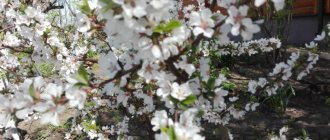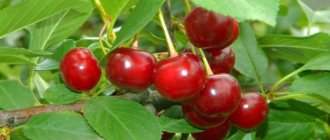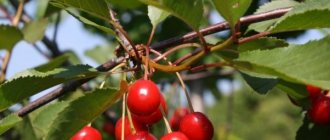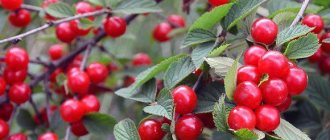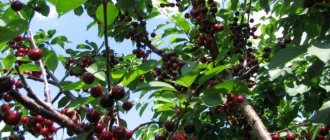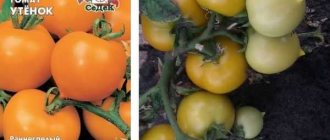Felt cherry Natalie is the brainchild of the Far Eastern Experimental Station VNIIR. Natalie was born back in 1979, thanks to the work of professional breeders. The work to create a new variety involved crossing the Leto variety with pollen from the Krasnaya Sladkaya, Ogonyok and Damanka varieties. In 1997, this felt variety was included in the State Register of the Russian Federation.
In today's publication you will learn a detailed description of the variety, see a photo of Natalie's cherry, and also read reviews from those summer residents who grew this bush on their site.
Benefits of growing
Before we start talking about the Natalie variety, let's figure out what advantages the felt cherry itself has in comparison with the usual one. Summer residents include primarily the following advantages of this variety:
- High decorative qualities. Such cherries can be grown not only to obtain good harvests, but also to decorate the site. Very often, felt varieties are used, for example, to create borders and hedges.
- High degree of frost resistance. Almost all felt varieties of cherries are excellent for growing not only in the Central regions of Russia, but also in the Urals or Siberia.
- Early ripeness. The fruits of felt cherries ripen about 1.5 weeks earlier than ordinary ones.
- Convenient harvesting. Unlike ordinary cherries, the fruits of felt varieties practically do not crumble when overripe. In addition, this variety never grows too tall. In this case, it is not necessary to stretch or use a stepladder to get fruits from the upper branches.
Of course, the felt cherry variety “Natalie” also has all these advantages.
Features of planting and care
Since felt cherry bushes do not produce root shoots, it is especially convenient to grow it from seeds. Seedlings grown by planting seeds retain most of the qualities of the mother plant, and are even better adapted to local conditions.
By planting a felt cherry seed at a depth of 4–5 centimeters in September, in the spring you will see the first shoots, and after 3 years, harvest the first harvest from the grown bushes.
The best place for the permanent growth of felt cherry is an elevated, well-lit area that is not characterized by high humidity. When transplanting, the seedling should not be buried too deeply in the ground, and a distance of 2 to 2.5 meters should be left between plants.
How to trim and shape a bush
Already in the first years of dynamic growth of cherries (up to half a meter over the summer), thickening of the bush should not be allowed, and starting from the sixth year of its cultivation, rejuvenation pruning should be carried out, which consists of shortening 2-3 old branches.
When growing felt cherries, you should be aware that most of its varieties require replacement every 10 years - after 6–8 years, the branches begin to die off, and its yield drops sharply. It should be noted that for a number of varieties, rejuvenating pruning is sufficient.
Principles of pruning and shaping bush cherriesTreatment with special preparations and fertilizing
To prevent infection with monilia during the flowering period of the felt cherry, the tree is treated twice with fungicides (Funazol, Horus, Skor or Strobi): first the buds are sprayed, then the flowers are sprayed before fruit formation begins.
For better swelling of the buds in the spring and to protect against diseases after flowering, felt cherries are treated with copper-containing preparations (Khom, Oksikh).
Felt cherries are fed once a year: immediately after flowering, a mixture consisting of 70 g of phosphorus, 30 g of nitrogen and 20 g of potassium fertilizers is added to the soil, as well as, depending on the power of the bush, from 5 to 7 kg of organic matter. It is recommended to lim the soil every 5 years.
Who developed the Natalie variety?
Russian summer residents have been growing this variety of felt cherry for a very long time. This variety was bred by domestic specialists in 1979. Work on it was carried out at the Far Eastern Experimental Station VNIIR. The fairly productive Leto variety was also used as a parent variety. Several varieties of cherries were used to pollinate its flowers. These were “Ogonyok”, “Red Sweet” and “Damanka”. Breeders N.A. and V.P. Tsarenko were involved in breeding the felt cherry variety “Natalie”. It was included in the state register in 1997. Since then, this variety has enjoyed constant popularity among summer residents.
Characteristics
Drought resistance, winter hardiness
Natalie is a felt cherry variety characterized by high winter hardiness. The trunk and branches of the bush can withstand frosts down to -35 degrees. Flowers tolerate spring frosts well (down to -3 degrees).
This variety is also highly resistant to drought.
Pollination, ripening time and flowering period
Felt cherry Natalie is an early variety. It blooms around May 20-27, the fruits ripen in the first or second decade of July.
The variety is self-sterile. Pollinators for Natalie's felt cherry should grow in the same area as it and bloom at the same time.
The following can perform well in this role:
- plum;
- peach;
- apricot;
- cherry plum;
- cherries of other felt varieties.
Productivity, fruiting
Felt cherry seedlings Natalie begin to bear fruit in the second year. The variety is characterized by high yield - 7–10 kg can be harvested from a bush. The berries will ripen en masse and at the same time.
The berries of Natalie's felt cherry are much less sour than those of ordinary cherries. There is no astringency in their taste. They contain: 12% dry matter, 8.3% sugar and 0.8% acids. The content of ascorbic acid in 100 g of Natalie berry pulp is 24 mg.
The tasting score of the Natalie variety is 3.8–4 points (with a maximum of 5).
The transportability of the fruit is low. They should be collected exclusively by hand. Natalie berries can be stored in the refrigerator for no more than 6 days. And only 3 days - at room temperature. It is advisable to process them immediately after collection.
Felt cherry “Natalie”: general description
Unlike many other varieties of felt cherries, Natalie bushes grow quite tall - up to 1.8 m. A characteristic feature of this variety is also a wide spreading crown of an ovoid or slightly flattened shape. The bushes of the Natalie variety do not look too dense. Their crown is very well ventilated.
Annual shoots of "Natalie" are pubescent and light brown in color. The gray bark on perennial branches is slightly peeling. The buds on the shoots of the Natalie variety are formed in threes at a time and have a pointed shape. The leaf blades that grow from them are dark green, elongated, and corrugated. On the upper side they, like the shoots, are pubescent. Their petioles are not too long and have stipules.
The flowers of the Natalie variety are not particularly large - they reach only about 2.5 cm in diameter. They are saucer-shaped. Each flower has five snow-white petals, one pistil and 27 stamens. The calyx of each flower is cylindrical in shape and pubescent on the outside.
Flowering and fruiting of the felt cherry “Natalie” is continuous along the branch.
Characteristic
It is necessary to familiarize yourself in advance with the characteristics of fruits and pollination of trees.
Possible pollinators
Natalie is a self-fertile plant variety that requires additional pollinators. However, they should be grown near cherry trees.
Among the most effective pollinators for plants are:
- peaches;
- plums;
- apricots;
- quince.
Fruit
The first harvest can be harvested only two years after Natalie is planted in the garden. If you follow all the recommendations for caring for the trees, you will be able to collect about 5-8 kg of cherries from each of them. The main feature of the fruit is its taste. Unlike other varieties of cherries, they do not have a sour taste.
The disadvantages of fruits include their poor preservation and transportability. The harvested crop is stored for no longer than a week.
Features of the variety
The “Natalie” cherry belongs to the early ripening self-sterile varieties. It blooms around May 10-18. You can harvest from the bushes of this variety as early as July 13-18. In addition to early ripening, summer residents also include the favorable ripening of fruits as an advantage of this variety. Own-rooted seedlings "Natalie" begin to produce crops in 3-4 years. Once grafted, it will be possible to pick berries in the second year. It usually grows in the Natalie garden until it is 18 years old.
The yield indicators of this variety are very high - up to 9 kg per bush. Another advantage of this cherry is its frost resistance. In winter, the branches practically do not freeze. Spring frosts do not have any effect on the flowers of this plant. This variety is also drought resistant. However, it is highly not recommended to over-water the Natalie cherry. Otherwise she may dry out.
With regard to the resistance of this variety to various diseases, summer residents have mostly only positive reviews. For example, the “Natalie” cherry almost never becomes infected with coccomycosis or clasterosporiosis. Over-watering this variety, among other things, is not recommended because in this case the plant may develop moniliosis.
Felt cherry “Natalie” has another important advantage. Judging by the reviews of summer residents and the manufacturer’s statement, it is very easily propagated by green cuttings. It is believed that this high-yielding variety is best suited for cultivation in intensive gardens, nurseries and hobbyist plots.
Description of culture
Felt cherry Natalie is a tree-like spreading shrub from 1.7 to 2 m tall.
Comment! This type of cherry is called “felt” because of the small, delicate fluff that densely covers the underside of its leaves, as well as young shoots, pedicels and even fruits.
The bush is wide, ovoid or slightly flattened oval in shape, with medium density. The perennial branches are thick, gray in color, and covered with rough bark. Young shoots are greenish-brown.
The buds are small, pointed, slightly deviated from the shoot. Natalie's leaves are light green, small (up to 6 cm long), wrinkled, with a pointed tip. The edge of the leaf blade is corrugated. The length of the petiole is 7 mm, the thickness is average.
The flowers are numerous, large (from 2 to 2.5 cm in diameter), saucer-shaped. Initially they are white-pink in color, after a week they fade and become completely white. There are five petals. The type of flowering is continuous, this applies to all branches (both annual and perennial).
The fruits of the Natalie variety are very large for felt cherries (weighing up to 4 g). The shape resembles a wide oval, tapering downward. The peduncle is short (about 4‒5 mm), slightly pubescent, and can be separated from the fruit without effort. The skin is dark red, covered with short, barely noticeable hairs. The pulp is scarlet, dense, juicy, with small cartilages (like a cherry fruit). The seeds of Natalie's felt cherry are beige in color, oval in shape, and small (only 5% of the total mass of the fruit). The taste of the fruit is harmonious, sweet with pleasant sourness.
Natalie's life expectancy with proper care is up to 18 years.
Due to the universal characteristics of this variety, the cultivation of Natalie felt cherry is recommended in all regions of Russia. It is suitable for cultivation in nurseries, in intensive gardens (with fruit processing points close to each other), as well as for amateur gardening.
Fruit
The description of the felt cherry “Natalie” given above allows us to judge it as quite unpretentious. Among other things, the bushes of this crop, in comparison with other varieties, grow very large berries. Their average weight is 4 grams. The fruits of the Natalie felt cherry are dark red in color. The skin of ripe berries is covered with short hairs. The pulp of the fruits of this variety is cartilaginous, dense, and juicy. According to many farmers, its taste is simply excellent. The juice of the fruit is red, sweet and sour.
Judging by the description of the felt cherry variety “Natalie” (the photo on the page also confirms this), its berries are really large in size. It is believed that the fruits of this crop are excellent for both processing and fresh consumption. If desired, you can make not only jam, preserves, compote or marshmallow from the berries of this cherry. Many owners of summer cottages make very tasty wine from them.
Pros and cons of the variety
Natalie is characterized by positive and negative sides that the gardener needs to know and take into account.
- differs in large-fruitedness among similar varieties;
- semi-dry berry pick;
- harmonious, sweet and sour taste of fruits;
- versatility of berries;
- unusual, spectacular appearance, possibility of use in landscape design;
- high level of frost and drought resistance;
- resistance to many diseases and pests;
- early ripening, friendly, abundant fruiting;
- high and stable yields.
- at high humidity and stagnant water, flowers and fruits are affected by moniliosis;
- mandatory presence of pollinators on the site;
- poor keeping quality and transportability of fruits;
- intolerance to waterlogging.
How to choose the right landing site
In the garden, it is advisable to place the felt cherry “Natalie” in the sunniest area. This will allow you to obtain maximum yields in the future. The advantages of this variety, among other things, include its undemanding nature regarding soil composition. Cherry “Natalie” will grow well on almost any soil. But it is best to choose for it an area with fertile and light-textured soil. A prerequisite for this is the absence of nearby groundwater.
“Natalie” is a self-sterile variety. This means that growing only one seedling in the garden is pointless. In this case, it will be impossible to obtain a harvest. Next to “Natalie”, for example, other felt cherries must grow. In this case, its flowers will produce many ovaries. Among other things, this variety has one very interesting feature. Its flowers can also be pollinated by related fruit crops. For example, cherry plum and plum are good pollinators of the Natalie cherry.
Recommendations for planting
Due to its good frost resistance, the variety can be planted in autumn and spring, immediately after the snow has melted. When planted in spring, the roots take root better and withstand cold weather more easily, and when planted in autumn, the plant gains strength over the winter before flowering and strengthens its immunity. Each gardener chooses the timing as desired. Natalie loves sunlight very much and, on the contrary, does not tolerate shading. The berries will ripen quickly, and the color will be intense if the tree has enough sun. In addition, before planting cherries, several features are taken into account:
- soil composition. There must be sand and peat in the ground. It is allowed to grow the crop in loamy and sandy soil. The soil should not retain moisture in the ground; excess water contributes to the development of rot on the roots and the formation of fungal spores;
- age and quality of the seedling. The roots of a healthy plant should be already developed and white in color. The length of the seedling is no more than 60 cm.
When the planting date has been decided, you can begin the process itself:
- Natalie forms a medium-sized bush; it looks compact on the site, so you will need a small hole for planting: depth - 60 cm, diameter - 60 cm;
- a nutrient mixture consisting of humus, soil and complex fertilizers is placed on the bottom;
- The seedling is inserted into the hole, covered with soil, but the root collar is monitored. It should be on the surface of the soil; deepening it too much will delay fruiting.
At the end of planting, the ground is carefully watered from a watering can, the consumption rate is 1-2 buckets of water per 1 plant. As soon as the moisture is absorbed into the ground, the soil near the tree trunk is mulched with humus or straw. Mulch protects roots from overheating and maintains water balance in the soil.
Attention! It will take 2-3 weeks for the seedling to adapt to the new territory.
Where to get planting material
You can grow “Natalie” on a plot either from a seedling or from a seed. But the first option is still preferable. The fact is that the seeds of the Natalie cherry need to be stratified before planting. Otherwise they simply won’t sprout. Stratification is a rather troublesome procedure. But if you wish, of course, you can try this planting option. In any case, “Natalie”, like almost any other felt cherry, does not lose varietal qualities when grown from seed.
Seedlings of the Natalie variety can be purchased at almost any nursery. Cherry is really quite old and popular among summer residents.
Reviews from gardeners
Valentina Igorevna, Kharkov, 42 years old.
At one time I grew several felt cherries, they are also called Chinese. Natalie was among them. What can I say, it didn’t catch on with us. No, not in the sense that it grew poorly or did not tolerate frost, but in the sense that I didn’t really like the taste. We have a small garden, and we always wanted to plant it with cherries. Friends advised me to plant felt cherries, they say they are productive and easier to care for than ordinary cherries. We tried their cherries, they seemed to be normal, but for some reason ours grew sour. We uprooted 5 felt bushes and planted ordinary cherries and sweet cherries.
Dmitry Ivanovich, Moscow, 51 years old.
Cherry is great. The yield is high, the cherries are rather small and sour, but we grow them purely for making jam. I was personally convinced that felt cherries are an excellent cherry for jam.
How to plant
The hole for the Natalie felt cherry should be dug quite large. The optimal indicators for its depth and diameter will be approximately 50 cm. The soil mixture for the seedling is prepared by mixing fertile garden soil with rotted manure. To feed the plant at first, a little slaked lime and some kind of complex fertilizer are also added.
The roots of the seedling itself are cut to about 20 cm. This ensures their better development in the future. The seedling prepared in this way is lowered into a clay mash. The soil mixture is poured into the hole in a not too thick layer. Next, install the seedling and cover it with prepared soil.
In order for the felt cherry “Natalie” to take root well, it needs to be planted at the same depth as in the nursery. At the final stage, make a roll of soil around the plant and water it thoroughly.
How to fertilize correctly
In spring, felt cherry "Natalie" is usually fed with mineral products. In this case, a complex composition intended for berry crops is used. For good development, cherries require both potassium (about 20-30 grams per plant), phosphorus (70-80 g), and nitrogen (30-50 g). In the fall, it is advisable to feed this variety with organic matter. Well-rotted horse or cow manure is best suited for Natalie cherries. You can also use compost. In any case, you need to pour about four buckets of organic fertilizer under each plant. This variety is usually fed in the fall immediately after pruning.
Felt cherry “Natalie” produces the best yields on neutral soils. Therefore, the soil underneath should be limed from time to time. This procedure is carried out approximately once every 5 years. In this case, about 200-300 grams of lime per 1 m2 are used.
Subsequent care of the crop
Felt cherry Natalie is pruned in the spring. For a tree younger than 5 years old, a crown is formed in this way, while an older plant requires it as a rejuvenating procedure. Regular and proper pruning can almost double the life of a cherry tree, which without it is about 10 years.
Natalie needs to be watered very moderately, no more than 3-4 times during the season, especially during periods of drought, making sure that the root collar does not prop up.
You should feed the felt cherry Natalie:
- in spring (mineral fertilizers);
- autumn (organic).
Important! To prevent the soil under the felt cherry from acidifying, it is limed (once every 5 years).
In the fall, when the harvest has already been harvested, you should carefully loosen the soil in the circle around the trunk, carefully inspect the bush, removing dried and damaged branches. It is also possible to wrap the trunks at the base with roofing felt or metal mesh to protect them from rodents.
Useful tips for planting and caring for felt cherries are in the video:
How to water
Excess moisture is, as already mentioned, something that the Natalie felt cherry really doesn’t like. Photos of healthy bushes of this crop are presented on the page. The poured Natalie cherry looks completely different. The beginning of damping off of this crop in the early stages can be determined, for example, by rotting of the root collar. In any case, “Natalie” should be watered moderately. It is necessary to moisten the soil under this plant mainly only during drought. Typically, bushes are watered no more than three to four times per season (about once every 1-1.5 months).
It is believed that it is best to moisten the soil under “Natalie” by sprinkling. This is explained primarily by the superficial occurrence of the root system. Using a hose, it can be easily washed. Actually, sprinkling itself should be carried out exclusively in the evening or morning. Otherwise, it will be possible to “burn” the leaves of the plant.
Further care
Subsequent care, including regular watering, proper fertilizing, preventive spraying and proper pruning, play a huge role in the life of the tree.
How to water
Felt cherry has good drought resistance and does not tolerate waterlogging. Therefore, you need to water carefully, especially in heavy, clayey soils. In the south, the plant is watered 1-2 times a week, in other regions - 3-4 times a month.
Tree feeding
Cherry responds well to the addition of organic matter (compost, humus, non-acidic peat). In the spring, when the buds open, the first fertilizing is carried out with nitrogen fertilizers, at the time of flowering and fruit ripening - with phosphorus and potassium fertilizers. After harvesting, felt cherries are fed with universal fertilizer, for example, Master 20.20.20.
Crown trimming
Formative pruning of the crown of young trees is carried out every spring, and sanitary cleaning is carried out throughout the season. For trees older than 5-6 years, with the onset of spring, anti-aging pruning is carried out, which can extend the life of the cherry by almost half - from 10 to 17-20 years.
Crown formation
The description of the felt cherry variety “Natalie” given above allows us to judge it as a fairly tall plant. This culture is actually developing very quickly. The same goes for her aging. Therefore, “Natalie”, like almost any other felt cherry, needs regular pruning. The technology of this procedure depends primarily on the age of the plant. The branches of two and one-year-old seedlings are cut off in the spring by about 1/3-1/4 if their length exceeds 60 cm. At the same time, all excess shoots are removed from the bush. Ultimately, the plant should have about 10-12 of the strongest branches left.
In subsequent years, in the spring, they mainly do only sanitary pruning of the Natalie cherry. That is, all frozen, dried and improperly growing branches are removed from the bushes.
At the age of 6-7 years, the felt cherry "Natalie", like many other varieties, may begin to experience a decline in yield. To prevent this from happening, you should do anti-aging pruning of the bushes. In this case, in the center of the crown of each plant, all old branches of the first and second orders are removed “in a ring”. Subsequently, new young shoots will begin to grow on the cherry next to the cuts. In the future they will produce good harvests.
In one place, the Natalie cherry can germinate for up to 18 years. However, experienced gardeners advise changing plants as early as fifteen years of age. Older cherries, unfortunately, do not produce particularly good harvests.
When pruning Natalie, it is advisable, among other things, to use garden varnish. They cover the “stumps” with it immediately after removing the branches.
Reproduction
Felt cherry is propagated by cuttings and layering. In the first case, cuttings 25-30 centimeters long are cut from mature branches in the spring. The lower cut is made oblique, and the upper cut is made straight, powdered with a rooting stimulator, and immersed in the substrate for 2-3 buds in a greenhouse or greenhouse.
In the second case, at the beginning of spring, lignified shoots are placed in grooves 6-8 cm deep, pinned with staples and sprinkled with soil. When propagated by seeds, the new plant does not retain all the maternal characteristics.
Diseases and their treatment
The most dangerous diseases of felt cherries are, according to many experienced gardeners, cleasterosporiasis and monilial burn. The felt cherry “Natalie,” as already mentioned, is quite resistant to the first type of infection. The risk of her developing a monilial burn is quite high. This infection in Natalie cherries can be determined primarily by the presence of dried brown shoots in the crown. Moniliosis is dangerous primarily because its manifestations are very easy to mistake for freezing during spring frosts or a burn when using insecticides.
Drying of shoots occurs in this disease due to the vigorous activity of a special type of fungus belonging to the Monilia family. The spread of this parasite can be facilitated by wet weather and various types of insects that carry spores from plant to plant. Already in the first year, due to this disease, the gardener may lose a large share of the crop.
It is not possible to cure felt cherry moniliosis “Natalie” using folk methods. The gardener will have to use a complex technique using chemicals. Treatment of this disease includes several mandatory measures:
- pruning infected branches;
- autumn cleaning of fallen leaves from under bushes;
- regular treatment with copper-containing preparations.
Diseases and pests
Natalie herself has a strong innate immune system. It is resistant to diseases such as coccomycosis and clasterosporiosis, however, if the bush is not taken care of, it may encounter pocket disease and monoliosis.
In order to protect the bush from possible diseases, the following preventive work can be carried out:
- In the spring, before the buds bloom, treat the tree with a solution of copper sulfate (100 g of copper sulfate should be diluted in a bucket of water).
- Periodically carry out sanitary pruning of bushes.
- In autumn, remove fallen leaves.
As for parasites, the most common pests of this felt variety are:
- Grape mite.
- Shield.
- Aphid.
- Leaf roller.
- Codling moth.
To prevent and combat these parasites, special pesticides or folk remedies are used, such as soap/garlic solution or wormwood infusion.
Reviews from summer residents about the variety
Gardeners have a very good opinion about the felt cherry “Natalie”, planting and caring for which is a relatively simple procedure. Among other things, this variety has earned good reviews for the excellent taste of the fruit. The berries of this cherry are sweeter than many others. At the same time, judging by the reviews, their taste is very rich. Summer residents also have virtually no complaints regarding frost resistance to Natalie cherries. The only thing is that this variety sometimes does not tolerate thawed winters very well.
Of course, many summer residents attribute the self-sterility of this crop to its disadvantages. However, pollinators of the Natalie cherry variety, plum and some others, are found in almost every garden. The main thing is to plant this plant closer to them.
The fruits of "Natalie" are somewhat larger than those of most other felt cherries. However, according to many gardeners, they are stored somewhat worse than many other varieties. Also, some disadvantage of “Natalie”, according to summer residents, is its tendency to rot. It is really worth being as careful as possible when it comes to watering with this variety.
Botanical certificate
To create an objective idea of a variety, you need to know its botanical characteristics, such as the size of an adult plant, shape, timing and size of fruiting, as well as the taste of the berries.
Tree dimensions
Cherry has good growth vigor, reaching 1.7-1.8 meters in height. The crown is wide, oval, medium dense. The branches are straight, dark brown, pubescent. The foliage is oval, 6x4 centimeters in size, corrugated, with a pointed nose.
Pollination, ripening time and flowering period
Cherry flowers are white, saucer-shaped, generally 2.0-2.5 centimeters in diameter. When flowering, they completely cover the branches, both young and perennial. Natalie blooms early - from the first ten days to the end of May, depending on the region, and the fruits begin to ripen from the first ten days to the end of July.
Moreover, the fruits ripen en masse, almost simultaneously, and the flowers themselves are resistant to early frosts.
For fruit to set, the variety requires the presence of other pollinating plants on the site. It is important that the timing of their flowering coincides with the flowering of this cherry. Both apricots, peaches and plums, cherry plums or other varieties of such cherries are suitable. But ordinary cherries or sweet cherries are bad pollinators for Natalie.
Productivity, fruiting, characteristics of berries
When planted as a grafted seedling, the variety begins to bear fruit from the second year of life. Natalie is distinguished by its high yield, reaching up to 7-10 kilograms from 1 bush. This variety is classified as large-fruited, but if the fruit branches are heavily loaded, the size of the berries may become somewhat smaller. Therefore, additional fertilizing with potassium fertilizers is required at the time of filling.
